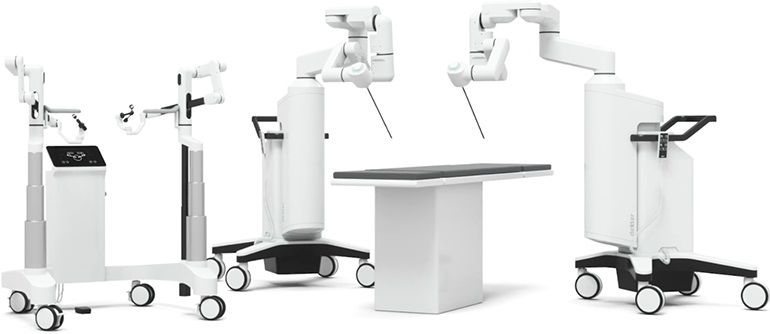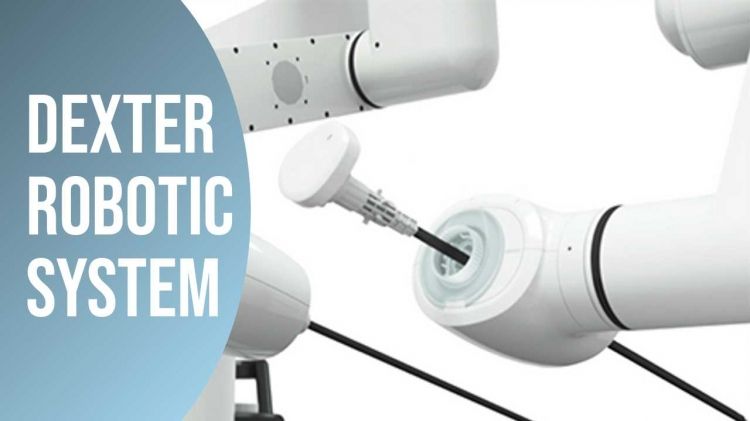The Dexter is created to be simple to bring in as well as out of the surgical area as well as used when robotic manipulation can help with enhanced precision, mastery, as well as comfort designs. Changing between robot surgical procedure and laparoscopy for the doctor is basically an issue of standing up from the console and also grabbing the devices by hand. The Dexter additionally comes with its own single-use 8 mm instruments for regular usage in dissection and also suturing, both mono- and bipolar.

Distalmotion asserts that the Dexter can be made use of alongside any type of commercial laparoscopic tower, allowing for 4k, 3D, ICG or any other existing or future imaging modern technology to be incorporated in addition to it. The console can be elevated and lowered, like a standing desk, to allow the cosmetic surgeon to run taking a seat or standing.
Dexter has already garnered remarkable passion in the medical neighborhood and also we expect to address the enhancing demand for a medical tool getting rid of the complexity out of robot surgical procedure to the fast lane its prevalent fostering in minimally invasive surgical treatment. Following the recognition of our product professional worth and advantages previously this year, and now expecting to start a wider activity enabling every client to access the advantages of robotic surgery.
Dexter is a surgical robot that was developed to provide surgeons with a tool for performing complex laparoscopic procedures with improved precision and control. One unique aspect of the Dexter system is that it is designed to work with conventional laparoscopic vision systems, allowing surgeons to use the equipment they are already familiar with. This essay will explore the principles of the Dexter surgical robot and its use in laparoscopic procedures.
Principles of the Dexter Surgical Robot
The Dexter surgical robot is designed to work with conventional laparoscopic vision systems, allowing surgeons to use the equipment they are already familiar with. The robot consists of two arms, each of which is equipped with multiple joints and a range of motion similar to that of the human arm. The arms are controlled by a surgeon using a console, which provides a 3D view of the surgical site and allows the surgeon to manipulate the arms with precision and control.
The Dexter system is designed to be compatible with a range of surgical instruments, allowing surgeons to use the instruments they are already familiar with. The surgical instruments are inserted into the patient's body through small incisions, typically using a laparoscopic approach. The surgeon then uses the console to control the movement of the instruments and perform the surgical procedure with improved precision and control.
One unique aspect of the Dexter system is its ability to provide haptic feedback to the surgeon. Haptic feedback allows the surgeon to feel the resistance of the tissue as they manipulate the instruments, providing a sense of touch that is similar to traditional surgical techniques. This can improve the accuracy and safety of the procedure and reduce the risk of complications.
Use of the Dexter Surgical Robot in Laparoscopic Procedures
The Dexter surgical robot has been used in a variety of laparoscopic procedures, including cholecystectomy, hernia repair, and colorectal surgery. In cholecystectomy, the Dexter system is used to manipulate the gallbladder and surrounding tissue, allowing for precise removal of the gallbladder while minimizing trauma to surrounding tissue. In hernia repair, the Dexter system is used to manipulate the hernia and surrounding tissue, allowing for precise repair of the hernia while minimizing trauma to surrounding tissue. In colorectal surgery, the Dexter system is used to manipulate the colon and surrounding tissue, allowing for precise removal of the affected portion of the colon while minimizing trauma to surrounding tissue.
Benefits of the Dexter Surgical Robot
The Dexter surgical robot offers several potential benefits over traditional surgical techniques. One of the main advantages is improved precision and control. The use of the robotic arms allows for precise manipulation of surgical instruments, which can improve the accuracy of the procedure and reduce the risk of complications. The use of haptic feedback can also improve the accuracy and safety of the procedure.
Another benefit of the Dexter surgical robot is reduced trauma to the patient. The use of small incisions and precise surgical techniques can reduce trauma to surrounding tissue and minimize the risk of complications. Laparoscopic surgery using the Dexter system can also result in faster recovery times and improved cosmetic outcomes.
The use of the Dexter surgical robot can also improve the efficiency of surgical procedures. The system allows for more precise and controlled movement of surgical instruments, which can reduce the time required for the procedure and improve patient outcomes. The Dexter system can also improve the safety of surgical procedures, as it allows for better visualization of the surgical site and can reduce the risk of damage to surrounding tissue and organs.
Challenges of the Dexter Surgical Robot
While the Dexter surgical robot offers several potential benefits over traditional surgical techniques, there are also several challenges associated with the use of this technology. One of the main challenges is the cost of the equipment and training required to use it. The cost of the Dexter system can be significant, and the cost of training surgeons and support staff to use the equipment can also be significant. This can limit the availability of the technology to specialized centers with the necessary equipment and facilities.
Another challenge is the need for specialized training and experience to use the Dexter system effectively. Surgeons and support staff must undergo extensive training to become proficient in the use of the robotic arms and the console, and experience is necessary to achieve the best results. The use of the Dexter system may also require changes to the surgical workflow and team dynamics, which can take time to implement and adapt to.
There are also concerns about the safety and efficacy of the Dexter surgical robot, particularly in comparison to traditional surgical techniques. While early studies have shown promising results for the use of the Dexter system in laparoscopic procedures, further research is needed to confirm the safety and efficacy of this technology.
Conclusion
The Dexter surgical robot is a promising new approach to laparoscopic surgery that offers several potential benefits over traditional surgical techniques, including improved precision and control, reduced trauma to the patient, and improved efficiency and safety. One of the main advantages of the Dexter system is its compatibility with conventional laparoscopic vision systems, which allows surgeons to use the equipment they are already familiar with. However, the use of the Dexter system requires specialized equipment, training, and experience, and there are concerns about the cost, safety, and efficacy of this technology. As the technology continues to evolve and improve, it has the potential to revolutionize the field of laparoscopic surgery and improve patient outcomes.
